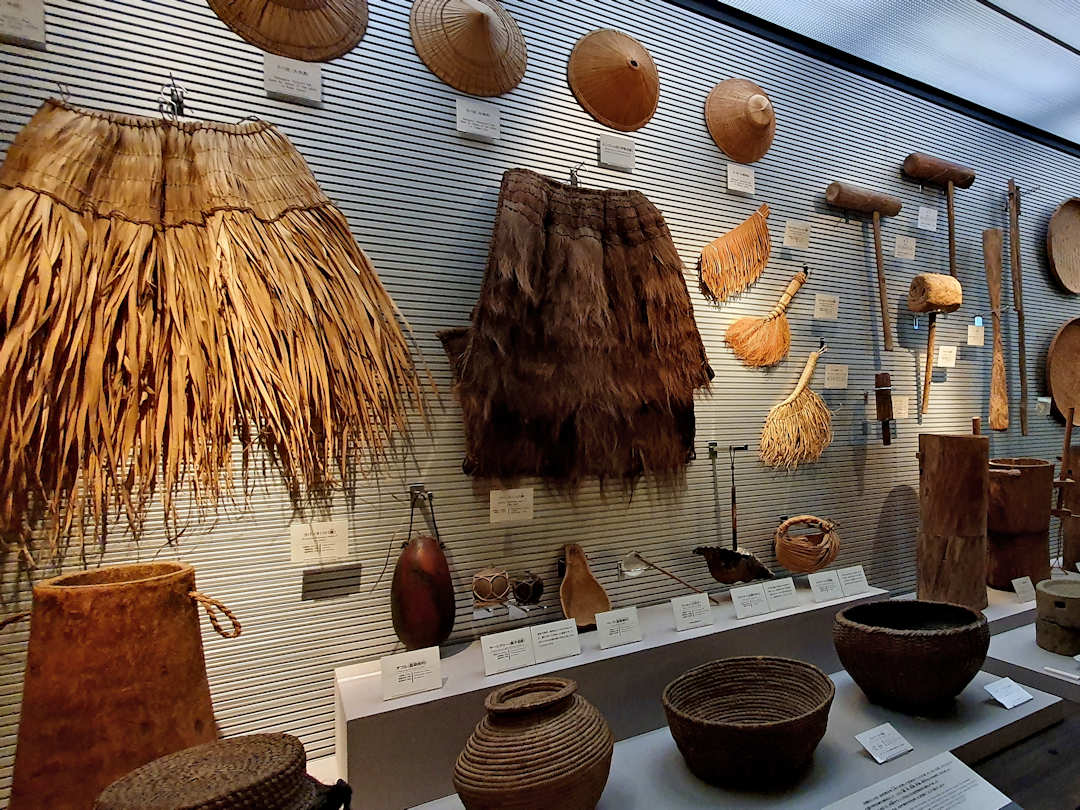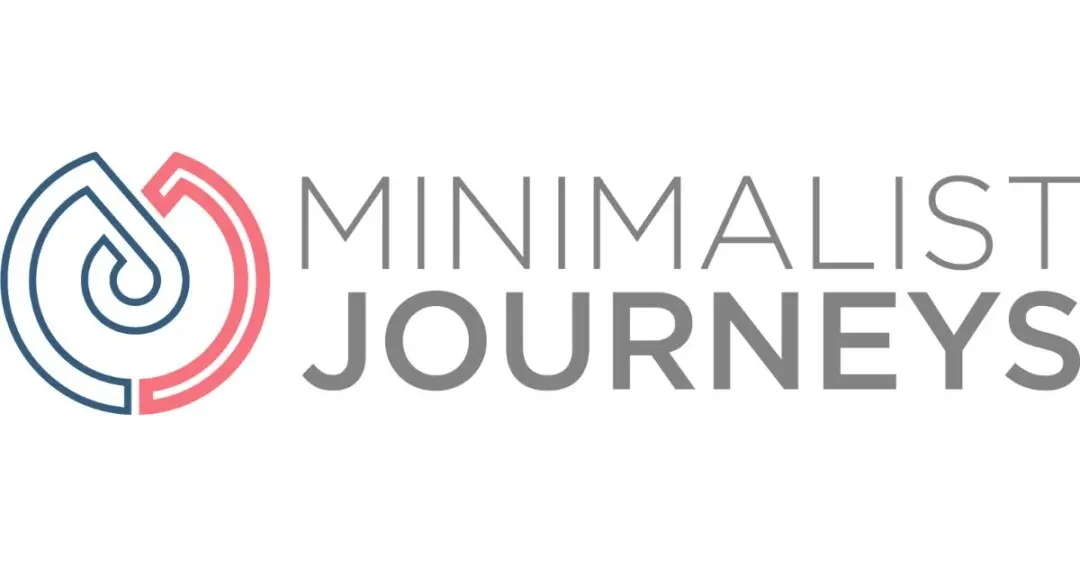This article may contain links to products and services we use and recommend. We may receive compensation when you click on links to those products. For more information, see our Disclosure Policy.
Okinawa might be best known for its stunning beaches and crystal-clear waters, but the Hawaii of Japan (as it is often called), has much more to offer than sun, sand and sea. With a unique history and culture shaped by its geographical location, Okinawa is distinctly different to the rest of Japan. Winter is a great time to experience the beauty of this region – with few other tourists around and perfect temperatures for outdoor explorations. Let’s take you on a winter getaway that has a bit of everything, with our 3-Day Naha/Okinawa itinerary.
Planning your trip to Okinawa at the last minute?
Book your transportation to/from and around Okinawa, keeping your carbon footprint in mind:
Find your perfect accommodation in Naha with Booking.com. We recommend these centrally located options near public transport:
Explore the wonders of Naha and beyond with the best tours and activities powered by GetYourGuide and Viator. We recommend these sustainable options:
We use and recommend Airalo eSIMs for affordable, hassle-free internet access in 200+ destinations. Activate before you arrive and get online instantly.
Map of Accommodation, Points of Interest, Eateries and Transport
Below is a map of the recommended accommodations, points of interest, eateries, and transport terminals or stops mentioned in this article.
Where is Okinawa, and what is it known for?
Okinawa is Japan’s southernmost prefecture. Located about halfway between Taiwan and the southern-most tip of the Japanese mainland, it comprises 113 islands (48 of which are inhabited) that are clustered around three island groups:
- the Okinawa Islands – which include Okinawa Hontō, the largest island of the archipelago,
- the Miyako Islands [Google Maps location], and
- the Yaeyama Islands [Google Maps location].
Formerly known as Ryukyu, after its indigenous people and the independent Ryukyu Kingdom that lasted from 1429 to 1609, Okinawa got its current name in 1879, when it became part of the Japanese Empire.
You may have heard of Okinawa as one of five blue zones worldwide, where people enjoy remarkable longevity. The residents of Okinawa have the highest life expectancy in Japan, which has been attributed to a healthy diet and an active lifestyle without stress.
Okinawa is also known as the birthplace of karate, a martial art born out of Okinawa’s unique history that is practised around the world today. You can visit the Karate Museum [Google Maps location] or take a Karate History Tour in Okinawa.

Among other things, Okinawa is known as the birthplace of Karate | Photo by Thao Lee on Unsplash
Sadly, the name Okinawa is also associated with one of the bloodiest battles in the Pacific—the World War Two Battle of Okinawa. Memorials and museums commemorate the events that have shaped Okinawa’s more recent history.
What many don’t know: After World War Two, Okinawa was under the United States of America’s administration until it was returned to Japan in 1972. To this day, Okinawa is a central strategic hub for the US military, with approximately 80,000 personnel and their families based on the island. Some parts of Okinawa feel more like Florida than Japan.

Okinawa is also the location of one of the bloodiest WWII battles in the Pacific, with repercussions lasting to this day
What is it like in Okinawa during winter?
Thanks to its subtropical climate, Okinawa offers a delightful escape from the colder winter temperatures in other parts of Japan and the northern hemisphere. Winter temperatures in Okinawa range from around 15 degrees Celsius to the mid-20s. And unlike the humid, muggy summer months, winters in Okinawa offer clear blue skies and minimal rain.
Okinawa kicks off Japan’s cherry blossom season – usually in mid-January. January to March is also whale-watching season. And if you’re wondering if winter is too cold for a swim, when Paul went swimming in Zamami on 18 February, it was refreshing and not too cold. Another advantage of heading to the beaches in Okinawa in Winter is that there are no bugs. However, be careful: life savers are only on duty between March and October.

Okinawa is the first prefecture in Japan to experience the Cherry blossom season | Photo by Yu Kato on Unsplash
Winter running events on Okinawa
If you're a keen runner and would love to run a marathon in Japan, Okinawa hosts two running races in Winter:
- the Naha Marathon in early December, and
- the Okinawa Marathon in mid to late February.
If you visit Okinawa in the summer, be aware that the Eastern Pacific typhoon season corresponds with the Hurricane season in the North Atlantic (01 June to 30 November), with most typhoons hitting the region in July and August.
For more details on the weather year-round, check out Weather Spark.
How much time should you spend in Okinawa?
With 113 islands and a geographic area of 2,281 square kilometres (880 square miles), you could spend years exploring Okinawa prefecture. So, if you have the time, stay as many days as you can afford – we promise you won’t get bored.
We recommend a minimum of three days for a good introduction to Okinawa and to experience some of its highlights off the beaten path. This gives you just enough time to visit important historical sites on the main island, explore some of the offshore islands near Naha, and immerse yourself in the unique culture of the region.
That said, if it’s your (first) two or three-week trip to Japan, and you can’t afford to spend three days in Okinawa, we recommend leaving Japan’s southernmost prefecture for another time – quality over quantity.
Introducing Okinawa: Your three-day (winter) itinerary
As a first-timer with (only) three days at your disposal, we recommend focusing on the south of Okinawa Hontō (the main island), its capital, Naha and the nearby offshore islands.
Day 1
Start your day with a visit to the Okinawa Prefectural Museum [Official website, Google Maps location] (closed Mondays). With its unusual design, modelled on Okinawa’s historical castles, the museum and its exhibits perfectly introduce Ryukyu history and culture.
Having worked up an appetite exploring the various exhibition halls, take a break for lunch at a nearby restaurant before heading to Shurijo Castle [Official website, Google Maps location]. If you jump on Bus number 7 outside the Okinawa Prefectural Museum, you’ll be dropped off outside the Shurijo Castle grounds).
Although the Shurijo Castle itself was tragically destroyed by fire in 2019 (its rebuilding process is due for completion in 2026), the remaining structures and surrounding grounds are still impressive and well worth a visit, as are the stunning 360-degree views (and you don’t need to pay anything to see them either).

While Shurijo Castle is being rebuilt after a fire in 2019, the castle grounds are worth a visit in their own right
After exploring the Shurijo Castle grounds, take a stroll down Kinjo Stone Road [Google Maps location] (a charming cobble-stoned street from the Ryukyu Kingdom) and then slowly walk up the other side to Shikina-en Garden [Official website, Google Maps location], the tranquil country residence of the Ryukyu royal family (closed Wednesdays).
Make sure to stop by Imai Bakery [Official website, Google Maps location], located 300 meters before the Shikina-en Garden (on your left), to pick up some delicious treats for afternoon tea.

Tranquil Shikina-en Garden was once the country residence of the Ryukyu royal family
Day 2
We suggest spending your second day exploring the Kerama Islands. Part of the Kerama Shotō National Park, the islands are within easy reach of Naha and offer plenty to see and do on a day or overnight trip. This one-day itinerary has everything you need to know.
Whether you choose Zamami [Google Maps location], Aka [Google Maps location] (which is connected by bridge to Geruma [Google Maps location] and Fukaji [Google Maps location]) or Tokashiki [Google Maps location], the islands are known for their turquoise waters, white-sand beaches and fringing coral reefs, and a visit will be an experience you’ll treasure for years to come.
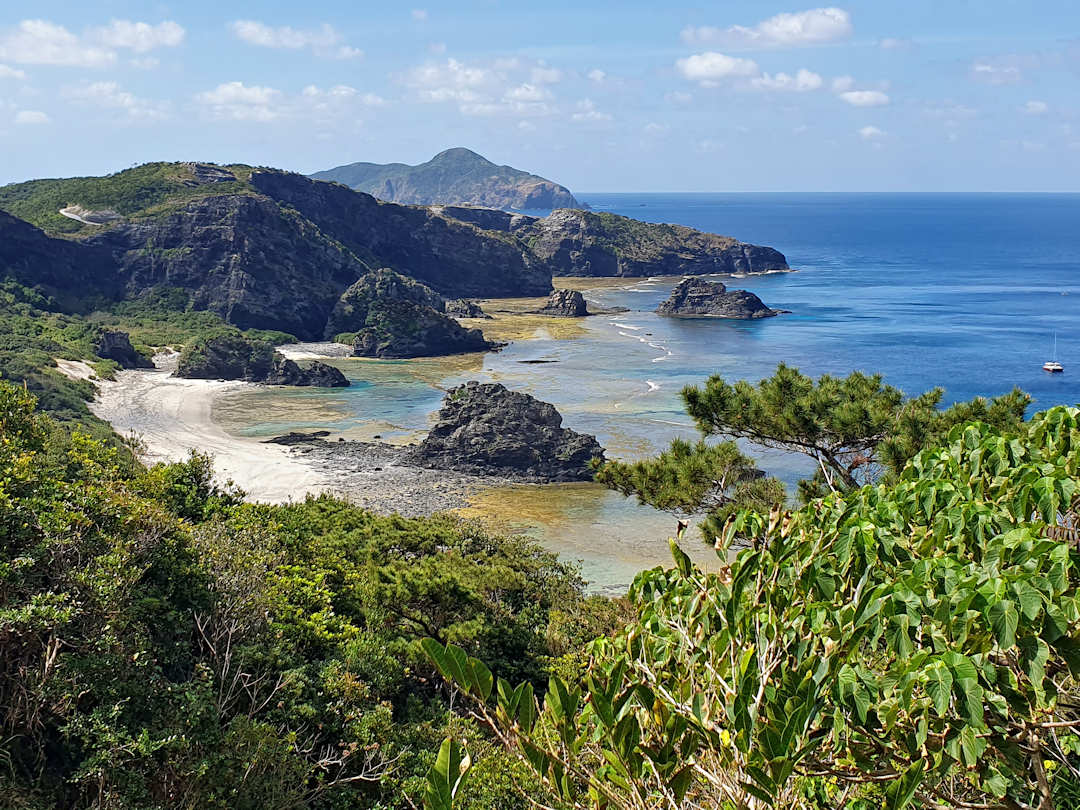
Unwind and recharge with a (multi)day trip to the stunning Kerama Islands
Day 3
Your final day on Okinawa is about the islands’ history from World War II. Prepare yourself mentally to hear and see some very sobering stories and images.
Himeyuri Peace Museum
We recommend starting your day with a visit to the Himeyuri Peace Museum [Google Maps location]. The Himeyuri Peace Museum shares the experiences (before and during the Battle of Okinawa) from the perspective of the school children who were mobilised to help the Japanese Imperial Army fight an unwinnable battle.
It’s over an hour by monorail and bus from Naha city centre or the airport. Expect to spend about an hour at the Himeyuri Peace Museum.

The Himeyuri Peace Museum shares the experiences of school children mobilised during the Battle of Okinawa
Peace Memorial Park
After your visit, continue by bus (for another 10 minutes or so) to the Peace Memorial Park [Official Website, Google Maps location] at Mabuni Hill, the location of the final and bloodiest fighting during the Battle of Okinawa.
The grounds of the Peace Memorial Park are vast. We recommend heading to the Prefectural Peace Memorial Museum [Official website, Google Maps location]. While the Museum design struck us as an odd choice (it looks like a holiday resort from the outside), it is a worthwhile source to learn more about the Battle of Okinawa, with a free audio guide enabling visitors to listen to the stories of survivors. Unlike the Himeyuri Peace Museum, it also showcases post-war life in Okinawa (including on US military bases). Expect to spend about two hours at the Prefectural Peace Memorial Museum.

Now home to the Peace Memorial Park, Mabuni Hill was the location of the final Battle of Okinawa
Afterwards, pay your respects at the Cornerstone of Peace [Official website, Google Maps location] – a memorial made up of black granite walls that contain the more than 240,000 names of the victims of the Battle of Okinawa and face an eternal flame overlooking the sea. It’s such a peaceful place today – it’s hard to imagine the atrocities that took place here in 1945.

The Cornerstone of Peace holds the more than 240,000 names of the victims of the Battle of Okinawa
If all the reading, watching and listening made you hungry, a small shop/restaurant is opposite the museum. It’s owned by a lovely elderly lady who serves cheap and delicious soba noodles.
Alternative WWII sites on Okinawa
If you prefer to stay closer to Naha but still visit some of the sights associated with Okinawa’s WWII history, we can also recommend the following:
Former Underground Headquarters of the Japanese Imperial Navy
Dug into a hill south of the Motobu River in 1944, this military fort [Official Website, Google Maps location] housed up to 4,000 soldiers during the Battle of Okinawa. From here, the Commander of the Japanese Imperial Navy led his troops in the Battle of Okinawa. It’s also the location where the Commander and his closest staff committed collective suicide when Japan’s defeat could no longer be denied.
It is a 15-minute bus ride from the city centre and a short but steep uphill walk. From the Himeyuri Peace Museum (or the Peace Memorial Park), it’s over an hour by bus (albeit on your way back to Naha).

The Commander of the Japanese Imperial Navy led his troops in the Battle of Okinawa from a military fort dug into a hill south of Naha
Hacksaw Ridge
The site of the Urasoe Castle (Urasoe Gusuku) [Google Maps location] ruins dating from the 13th century and officially known as the Maeda Escarpment (Maeda Kochi) experienced some of the most ferocious fighting between the Japanese Imperial Army and the US Forces in the early days of the Battle of Okinawa.
While there are maps and displays at Maeda Escarpment (including in English), this detailed guide might be another helpful resource. It also pays to (re)watch the movie Hacksaw Ridge before your visit.
From the city centre, it’s a 20-minute ride on the monorail to Urasoe-Maeda Station, followed by a 10-minute uphill walk to the southern entrance (turn right before the footbridge and walk along the paved path to the left of the parking lot). While it is possible to add after a visit to the Himeyuri Peace Museum or the Peace Memorial Park, it’s about 2 hours by bus and monorail from there to Hacksaw Ridge [Google Maps location].

The bloody WWII battle at the Maeda Escarpment featured in the movie Hacksaw Ridge
What to do if you’ve got more than three days in Naha/Okinawa?
If you’ve got more time to spend in Naha, we can also recommend to visit the following sights in the city centre (all are within walking distance from each other):
- Fukushū-en Garden [Official Website, Google Maps location] (closed Wednesdays) – Opened in 1992, this picturesque and tranquil Chinese Garden celebrates the centuries-old relationship between Naha and its sister city, Fuzhou, in China.
- The Tsushima Maru Memorial Museum [Google Maps location] (closed Thursdays) – The museum commemorates the sinking of the Tsushima Maru by a US submarine on 22 August 1944, killing more than 1,500 civilians on board (including 800 children).
- Naminoue Shrine [Google Maps location] – A sacred Ryukyu site, this beautiful Shinto shrine sits on a rock above Naha’s waterfront and next to the small beach bearing the same name. It’s a popular place for weddings and baby blessings.

Naminoue Shrine at Naha's waterfront is a popular place for newly engaged couples, weddings and baby blessings
And if you prefer joining an organised (half)day tour, here are our recommendations:
How to get to Naha/Okinawa?
Thanks to its international airport (OKA) [Google Maps location], Naha is well connected to other cities across Japan (often with direct flights) and major cities across Asia (including Bangkok, Beijing, Hong Kong, Seoul, Singapore and Taipei).
For those wanting to bring their vehicle from mainland Japan, there are also domestic ferry services from/to Kagoshima, provided by A-Line and Marix Line. Other islands of the Okinawan archipelago can all be reached via Naha – by ferry and/or aeroplane.
Unless you’re willing to spend more than 24 hours on a ferry, you might arrive in Naha by plane. Naha International Airport is located on the southwestern coastal outskirts of Naha city, in easy reach of the city centre (and other parts of the island) by monorail and/or bus (which take 10-15 minutes to Naha’s Central Bus Terminal).

How do you get around Naha/Okinawa?
Transport options
Okinawa Hontō (the main island) has a reasonably good public transportation system, consisting of a 17-km monorail line (called Yui Rail and operating from 0545h to 2330h) and an extensive bus network. While buses serve almost every corner of Okinawa, taking the bus from the Naha Airport all the way to the island’s northernmost point (a journey of 110km as the crow flies) would take 4.5 to 5.5 hours one way.

Buses serve almost every corner on Okinawa, but travel by bus takes time
Suppose you want to explore sights further north. In that case, one option is to take the Jinbei Marine high-speed ferry from Naha to Motobu [Google Maps location] or Nago [Google Maps location], both located on the northwest coast of Okinawa and continue by bus from there. The ferry leaves from Tomari Port’s northern pier [Google Maps location] (in front of the Marine Liner Tokashiki). With its blue whale shark painting, it’s easily recognisable in port.
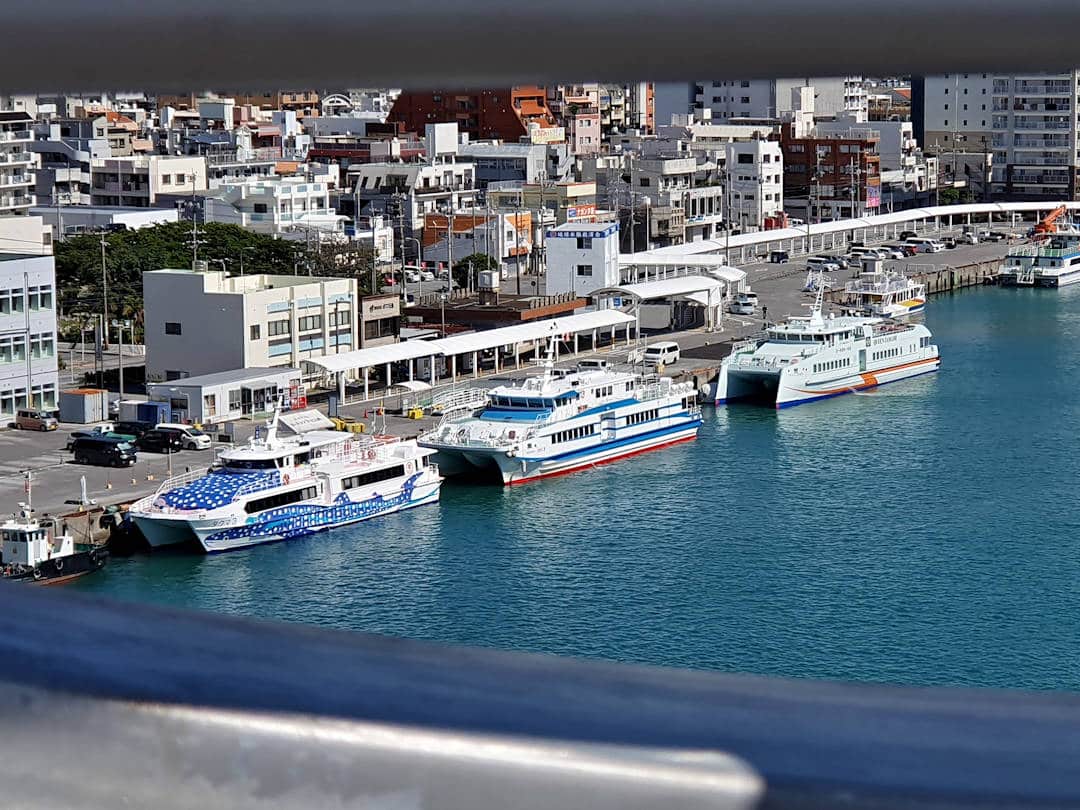
Naha's Tomari Port Northern Pier is the departure point for the Jinbei Marine Ferry, the Marine Liner Tokashiki and the Queen Zamami
Rental cars are an option. However, a speed limit of 60 kilometres per hour applies on the island – except the Okinawa Expressway (E58), where you can drive up to 80 kilometres per hour. If you plan to hire a motorised vehicle – in Okinawa or mainland Japan – you must bring your national driver’s licence AND an International Driving Permit (IDP). In many countries, these are issued by the National Automobile Association.
Taxis are also available around the island (including from the airport). Just order one via Didi or another Japan Taxi app.
How to find the best deals on rental cars
Most of the time, we use public transport to get us around. But occasionally, hiring a car or scooter just makes it easier or gets us to places we couldn't go without a set of wheels. Whenever we do hire a vehicle, our first point of call are local rental providers. A quick Google Maps search shows who's near us. We then check the reviews and only contact those other travellers had good experiences with.
If we can't find anyone we're comfortable with, we search for deals on aggregator websites. We've used Rentalcars.com and DiscoverCars.com in the past and had only good experiences with them. Both partner with trusted brands like Hertz, Avis, Budget or Europcar (and in some locations even local providers) - so you can compare car hire options in a similar way you'd compare accommodation offers across Agoda and Booking.com.
Where can you buy public transport tickets in Okinawa?
Getting around Okinawa by bus or Yui Rail monorail is safe and easy. To pay for a ride, pay as you go in cash (especially on the bus) or with the IC card you’re using on the Japanese mainland (including PASMO and ICOCA). Note: While Okinawa has its own IC card (called OKICA), don’t buy one unless you plan to be here for a while or visit frequently, as the card can’t (yet) be used in other parts of Japan.
Tickets for the Yui Rail monorail can be purchased at the station where you want to commence your journey (fares are based on your destination).
Buses on Okinawa operate as they do on the mainland:
- In most cases, your fare will depend on the distance travelled. In that case, you pull a ticket from the dispenser as you enter the bus and then pay as you exit based on the fare displayed on the board above the driver for the number on your ticket.
- In some cases, you pay a flat fee. In those cases, the driver asks you to pay as you enter the bus.
- Either way, you must throw the correct amount into the catcher next to the bus driver. If you don’t have the correct amount, change it (in the machine next to it) before you throw your coins into the catcher.

In most cases, bus fares on Okinawa are paid upon exiting based on the distance travelled (and as indicated on the display above the driver)
Are there (multi)day public transport passes?
If you plan to use the Yui Rail monorail multiple times a day, you can purchase 24- and 48-hour passes from the vending machines at the monorail stations (for JPY800 and JPY1400, respectively).
One- and Three-Day Public Transport Passes are also available (called Okinawa Pass, which is available for bus only OR for bus and monorail), which might be worth considering. Using Google Maps to determine how to get from A to B will also tell you the expected (normal) fare. Do your sums to see whether getting the pass is worthwhile. Following our itinerary, it might be worth getting the One-Day Bus Pass on day 3 (especially if you plan to visit both the Peace Memorial Park AND Hacksaw Ridge).
Public transport passes can (only) be purchased at the Tourism Information Desk in the domestic airport arrival hall, located to the right of the Airport Information Desk (best done upon arrival). However, note that the staff need to know the exact date/s you will use the pass as it/they will be stamped onto it.
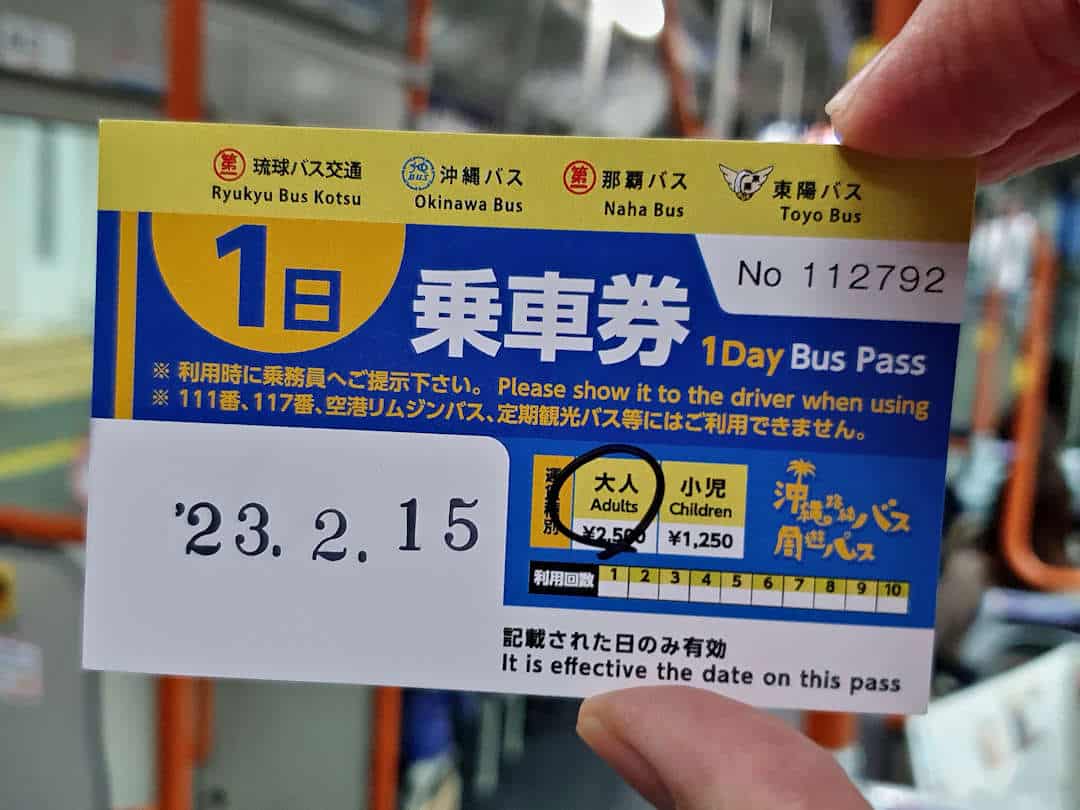
The Okinawa Pass must be bought at the Airport Tourism Information Desk (and is only worth it if you are travelling a lot in one or three days)
Where to stay in Okinawa
With a length of approximately 110 kilometres/68 miles, travelling between the different parts of Okinawa island (even if you drive) takes a long time. So, deciding where to stay will depend on what you want to see and do.
Suppose you are following our itinerary and prefer using public transport to get around. In that case, we recommend basing yourself in Naha city centre, particularly between the Meiji Bridge and Tomari Port (south-north) and between the waterfront and Highway 330 (west-east).
| Name | Property Features | Location | Type | Price Indicator | Book Now |
|---|---|---|---|---|---|
| Naha Short Term Accommodation | Naha | Apartment | $$ | Book Now | |
| La Passione Boutique B and B | Coffee Shop Laundry Service | Naha | Apartment | $$ | Book Now |
| Kariyushi Condominium Resort Naha Ryujin Hotel Ukishima | Laundry Service | Naha | Apartment | $$$ | Book Now |
| Hotel Tenshikan Kumoji | Smoke-free property Laundry Service | Naha | Apartment | $$$ | Book Now |
| Okinawa Hinode Hotel | Swimming Pool Laundry Service Restaurants | Naha | Hotel | $$$ | Book Now |
| Almont Hotel Naha-Kenchomae | Spa Buffet breakfast | Naha | Hotel | $$$ | Book Now |
| Community and Spa Naha Central Hotel | Hot tub and Sauna | Naha | Hotel | $$$ | Book Now |

Umibudo or Sea Grapes (best with ponzu sauce) are a local specialty you can try in Naha | Photo by Kaori Kubota on Unsplash
Dreaming of exploring Japan without breaking the bank?
Where (and what) should you eat in Naha/Okinawa?
If you’re into sampling local specialities, we can recommend the following:
- Enjoying a set lunch at Yunangi (a restaurant just off very busy Kokusai Dori Shopping Street) [Google Maps location]. The place is open from 1200h to 1500h (closed Sundays). There will be a queue outside at 1200h, but seating is very efficient, and if you head there at 1300h, you should get a table immediately.
- Joining a free tour of the Chukogura Distillery [Goolge Maps location] (closed Thursdays). This family-owned business has made Awamori (a liquor synonymous with Okinawa) for three generations. The distillery is one of only a few that make aged Awamori. I tasted 16-year-old Awamori, and it reminded me a lot of Brandy. The tour and tasting are held in Japanese, but there is signage in English, and the lady guiding our tour spoke English (so you can always ask questions if something doesn’t make sense). You do have to reserve your spot in advance.

The Chukogura Distillery in Naha is one of only a few that make aged Awamori - Tours of the facilities are free of charge
Special souvenirs from Okinawa
We don’t personally buy souvenirs (our souvenirs are the photos we take and the memories they invoke), but if you’re after something special from Okinawa, head to Studio Churaumiya in the Heiwa Dori Shopping Street in Naha. The art studio allows you to create unique souvenirs, including making your own (mini) shisa – the guardian lions you’ll encounter at (almost) every house in Okinawa.

For a special souvenir from Okinawa make your own mini shisa at Studio Churaumiya
How to stay safe in Okinawa?
Okinawa is considered a very safe destination by global standards, reflecting Japan’s reputation for low crime rates. According to the United Nations Office on Drugs and Crime (UNODC), Japan’s intentional homicide rate is one of the lowest in the world, at 0.23 per 100,000 people (UNODC Global Study on Homicide). While Okinawa reports slightly higher rates of minor crimes, such as theft, compared to other Japanese prefectures—partly due to its tourism and US military bases—the overall crime levels remain exceptionally low. A 2022 report by Japan’s National Police Agency confirms that violent crime is extremely rare (National Police Agency Crime Situation in 2022 White Paper). Visitors are encouraged to use basic precautions, such as securing valuables, to minimise the already small risk of petty theft.
Sunburn and snake bites are other risk factors to be mindful of. To avoid sunburn (even in winter), wear sunscreen with SPF50+, a hat, and sunglasses.
How do you avoid snake bites, and what do you do when you get bitten?
While Okinawa has eight venomous snakes, most of them are not dangerous. Those to watch out for are habu (pit vipers), most active between March and October. They hibernate over winter in a sheltered place, so it's unlikely you encounter one during the coldest season. If you do, move back and leave them alone. Also, wear long pants and closed shoes, and stay on hiking/walking trails.
If a snake bites you, stay calm and limit movement to slow the spread of venom. Do not attempt to suck out the venom or apply a tourniquet. Seek immediate medical attention and call emergency services, providing details about the snake if possible. For further guidance, consult the World Health Organization's snakebite information.
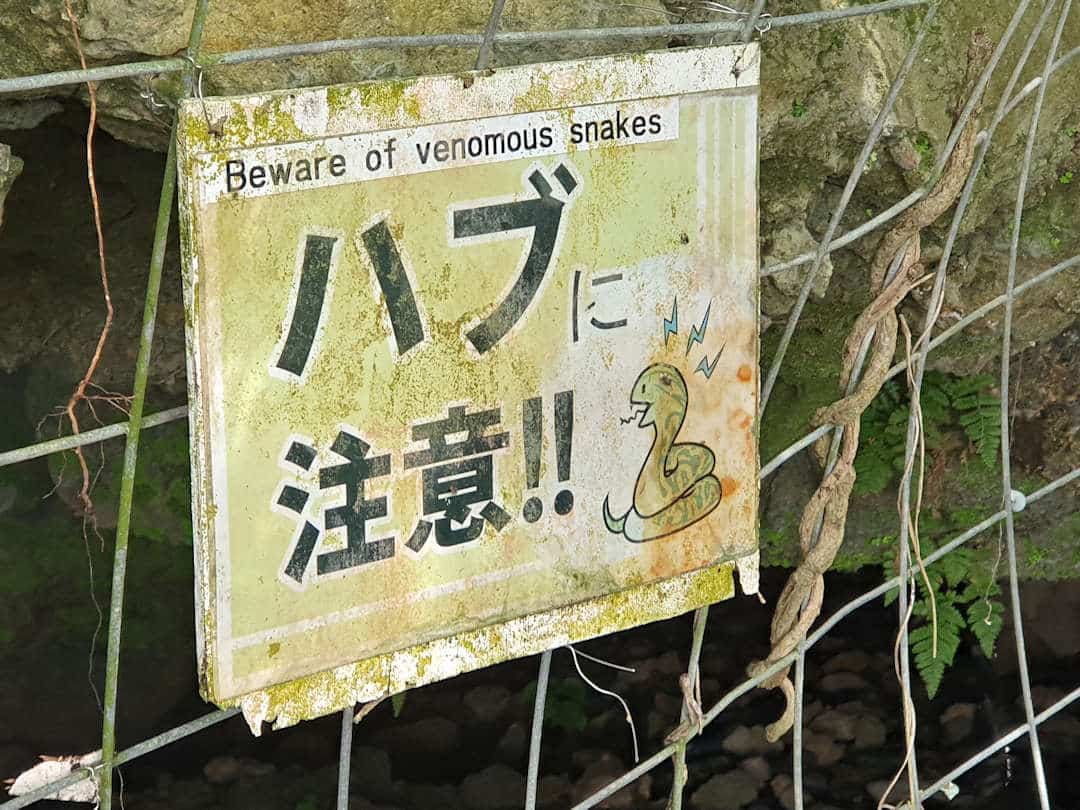
Watch out for habu (pit vipers) when visiting Okinawa - especially when you see signs like this one
Have you visited Okinawa Hontō?
I wrote this Okinawa travel guide and itinerary based on my own experience. If you have been to Okinawa and have something to add to this list of sustainable and affordable things to do, please get in touch with me.
Before you go, if you liked our article and found it helpful, we would appreciate it if you could share it with your friends and family via the Share buttons below. Even better: Leave a short review on Trustpilot or Google, which would help us further build our online reputation as a (trustworthy and helpful) travel and lifestyle blog.


